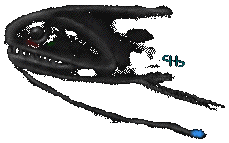T h e
B i o l u m i n e s c e n c e W e b P a g e
 |
|
















|
 |
|
A N N O U N C E M E N T S (Updated:
Sep 23, 2025
)
- Educating and inspiring since 1997
- A large-format photo book shows never-before seen images of bioluminescence and fluorescence from live animals.
- A review of midwater ecology, about animals living in the ocean's deep-sea twilight zone, talks about bioluminescence as an adaptive strategy.
- This review paper covering research on bioluminescence provides an in-depth resource.
- A video about Bioluminescent Corals shows their dynamic luminescent displays, filmed from a sub as deep as 4000 meters below the surface.
- Capturing videos of bioluminescence from the deep sea.
- Video about Fluorescence describes a way that animals use it in the ocean, and the difference between fluorescence and bioluminescence.
- A set of U.S. Postal Stamps celebrates bioluminescence, and includes one of our photos from this site.
- The New York Times used our images in a special feature on bioluminescence research.
- Bioluminescence from space. Using a satellite, scientists have detected an even larger "milky sea" of bioluminescent bacteria.
- We have updated our Photo page with one-of-a-kind color photos of luminescent organisms.
- A in-depth study shows that more than 3/4ths of the macroscopic organisms living in the water deep water column are bioluminescent.
- We updated our Chemistry Page with some up-to-date additions of organisms that use coelenterazine as their luciferin.
- Content of interest:
- Read more about the site and see some of the other pages linking to us at the bottom of the About page.
|
|
Bioluminescence is simply light produced by a chemical reaction which originates in an organism.
It can be expected anytime and in any region or depth in the sea.
Its most common occurrence to the sailor is in the often brilliantly
luminescent bow wave or wake of a surface ship. In these instances
the causal organisms are almost always dinoflagellates, single-cell
algae, often numbering many hundreds per liter. |
|
 |
They are mechanically excited to produce light by the ship's passage
or even by the movement of porpoises and smaller fish. |
|
The deep-sea fish Aristostomias has more than one light organ. Read more about this and other
amazing adaptations. (Illustration © Steven Haddock)
|
|
Bioluminescence is a primarily marine phenomenon. It is the predominant
source of light in the largest fraction of the habitable volume
of the earth, the deep ocean . In contrast, bioluminescence is
essentially absent (with a few exceptions) in fresh water, even in Lake Baikal.
On land it is most commonly seen as glowing fungus on wood (called foxfire), or in the few families of luminous insects. (For firefly information, try here.)
Bioluminescence has evolved many times in many taxonomically distinct species in the sea as evidenced by the several distinct chemical mechanisms In these organisms in serves many functions, some of which have not yet been explored.
Bioluminescent bacteria occur nearly everywhere, and probably
most spectacularly as the rare "milky sea" phenomenon, particularly
in the Indian Ocean where mariners report steaming for hours through
a sea glowing with a soft white light as far as the eye can see.
Find out more about the basic properties of bioluminescence. |
|
|
|
|
This page is continually being revised.
Send suggestions, questions and comments to the BL Web administrators ( ). ).
|
|

About the page | Research Forum | Organisms |
Chemistry | Contribute | Photos
Send comments to  Last modified: Sep 23, 2025 Last modified: Sep 23, 2025
 |
`
 Last modified: Sep 23, 2025
Last modified: Sep 23, 2025
![]()
![]()

 ).
).![]()
 Last modified: Sep 23, 2025
Last modified: Sep 23, 2025
![]()